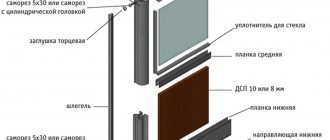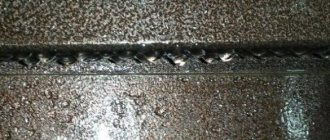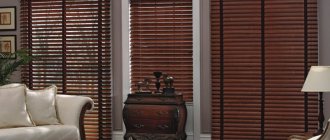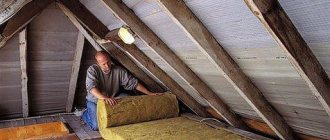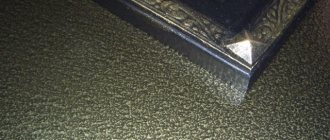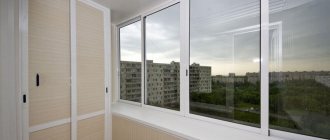Advantages of thermal protection
Thermal insulation of a wooden door provides a range of benefits that must be carried out. They consist of improving the indoor microclimate.
Such work makes it possible to protect housing from extraneous noise. With their help you can change the design of the structure. Carrying out this work will make the door more reliable.
Tool
It is impossible to get the job done without the right set of tools. To create insulated wooden entrance doors you will need:
- Tape measure and pencil;
- Stationery knife;
- Hacksaw;
- Hammer;
- Screwdriver;
- A flat rod or metal meter;
- Mounting tool or nail puller;
- Construction stapler.
It is necessary to prepare tools and lining material.
If necessary, this set can be expanded, but for most operations it will be quite sufficient. It should be noted that a hacksaw can easily be replaced with an electric jigsaw. This tool allows you to get the job done with the same quality, but much faster. And if there is no screwdriver in the house, then you can take a simple drill. The main thing is that it has a reverse, which will allow you to unscrew any self-tapping screw or screw if necessary.
In addition to the tools, it is necessary to prepare the covering material. For most door panels, it will be enough to use leatherette, which has an attractive appearance. This material has good characteristics and wear resistance, so the canvas will not need to be repaired for a long time.
And if you like to do everything with your own hands, then we recommend you instructions on how to make a wooden entrance door.
Materials
Builders advise how to insulate a wooden entrance door in a private house for the winter. Different materials can be used for this:
Izolon or foam rubber
You need to apply glue to the outside of the door, and insulation or foam rubber on top. Also, such materials can be glued to liquid nails. Glue is used to prevent the insulation from moving during work. Foam rubber is not toxic.
Styrofoam
Method 1. Place polystyrene foam or polystyrene foam 30 mm thick on top of the canvas, fix it with liquid nails, and then cover it with finishing material.
Method 2. Place a frame made of dry timber with a cross-section of 20x30 onto the plane of the door. Auxiliary stiffeners are formed from the same timber inside the frame. The base must be treated with a primer. Place polystyrene foam inside the cells. It is then coated with finishing material.
Styrofoam
Mineral wool
It is possible to follow the second method with polystyrene foam, or you can do it frameless. That is, nail it to the surface of the door leaf using a stapler. It is imperative to use a hydrobarrier film, because it protects the insulation from excess moisture.
Mineral wool is light in weight, so it is easy to work with. Not recommended for use on metal doors.
Dermantin
It is necessary to place it on the door leaf and secure it with nails or regular staples. Place dermantine on top and attach it with decorative nails. You can tuck it in and thereby form protective cushions against drafts.
How to insulate a wooden door. Tips, methods, photos.
The first autumn cold has arrived unnoticed, and if your apartment or country house has become uncomfortable like autumn, you should take a close look at the front door and windows - most likely, you will have to start insulating them. We won’t touch the windows now, let’s talk about the door, since this is where the most problems occur. Especially if the door is wooden and has served for many years.
Insulating a wooden front door is not as difficult as it might seem at first glance: having a simple tool and more or less stable handling skills, your personal desire and our advice will help correct the situation and meet the cold winter with dignity.
So, there are, by and large, only two ways to insulate the front door:
- Sealing the door frame in the areas where the door leaf adjoins;
- Insulation of the door leaf using thermal insulating materials.
Door seal
To seal the doorway, you will need to purchase a special rubber seal. This sealant, in the form of a tape rolled into a roll, is widely available and inexpensive, and has an adhesive base on one side, which greatly simplifies its installation.
Before going to a hardware store or market, you should measure your door along the perimeter, the length of which will correspond to the length of the insulation you are purchasing. Pay attention to the width of the folds: folds are the place where the door leaf adjoins the frame, and it is obvious that the width of the insulation should be similar or slightly smaller. Try to determine the width of the slot gaps - the sealing tape, due to its thickness when compressed, should completely cover the gap.
Having the results of simple measurements in hand, you can choose the right rubber seal, which is very easy to install. We seal the doorway in parts - the upper part along the width of the door, having previously cut off the corresponding piece of tape, then the vertical sections along the height of the door and, finally, the lower part. To glue a strip of insulation, you need to carefully press its adhesive side to the folded part, gradually removing the protective paper strip. Make sure that the seal lies evenly, without distortions, along its entire length.
Read also Siding for the house - an ideal and inexpensive solution
As, frankly speaking, a dubious alternative to a special rubber seal, if it is not possible to purchase one, they use the “old-fashioned” method in the form of a strip of leatherette folded in several layers, which is carefully nailed down with nails every 10-15 cm.
Insulation of the door leaf
As for the insulation of the door leaf itself, you can carry out internal insulation (disassembling a door with a hollow structure and filling its internal space with heat-insulating material - polystyrene foam or mineral wool) and external insulation, which we will talk about in more detail.
As a thermal insulating material, either polystyrene sheets (foam plastic) or soft materials are used - cotton wool, foam rubber, mineral wool or isolon, which are then covered with leatherette or leatherette. Of the listed materials, cotton wool and foam rubber are the least desirable, since they absorb moisture and become a breeding ground for harmful bacteria, and foam rubber also deteriorates over time.
Mineral wool has the only drawback - it gradually sags, deforming the original layer and disrupting the uniformity of volume; in all other respects good.
Isolon is a modern synthetic material that provides maximum thermal insulation with a small thickness. Izolon is good in every sense and can be recommended without any conditions or clarifications.
Soft door upholstery is a familiar way of insulating and decorating the front door, which used to serve as an indicator of the wealth and high social status of the apartment owner. Today, this method has not lost its relevance, except that it is now available to almost everyone. Both individual materials and standard sets are available for sale, consisting of insulation, upholstery material and decorative nails; sometimes there are materials for creating rollers for laying around the perimeter of the door.
Step 1. Remove the door leaf from the hinges and place it on trestles or stools.
Step 2. Place thermal insulating material on the insulated surface. To ensure that the sheet (or sheets) of insulation does not move during further covering with leatherette, first apply a sufficient amount of glue (PVA, “dragon”, “liquid nails” or another suitable) to the surface of the door and let the insulation stick well.
Read also How to make a cesspool on a personal plot. Expert advice. Photo
ATTENTION: the size of the insulation should be 1 cm less than the size of the door on each side, and if the side adjacent to the door is upholstered, you need to retreat one centimeter from the edge of the tightly closed door, otherwise it simply will not close later.
Step 3. We cover the door with insulation with finishing material - leatherette, leatherette, etc. To do this, you will need an assistant who will monitor the uniform tension of the canvas, preventing the occurrence of folds and distortions. You should start from the top of the door. Tuck the edge of the material evenly inward to the required width and attach it with special decorative nails, carefully nailing them at the same distance. Then, maintaining uniform tension, we nail the leatherette on the right and left sides, gradually moving towards the bottom. We finish the upholstery at the bottom in the same way.
Pay attention to the part of the door where the (previously removed) handle and mortise lock are attached: in this part it is necessary to cut out the required amount of the heat-insulating material used, also observing the “one centimeter rule”. The handle and lock installed in place will serve as additional fastening of the upholstery material. If your insulated door has a peephole installed, mark its exact location before removing it and then replace it using the previous recommendations.
Foam insulation is a slightly different method, which has two main types:
- gluing a sheet of polystyrene (foam plastic) pre-covered with leatherette using liquid nails to the surface of the door leaf;
- the construction on the surface of the door of a wooden frame with additional stiffening ribs, inside which well-fitted pieces of foam are placed, followed by lining with clapboard or laminated fiberboard.
The second method, of course, is preferable, but it can significantly increase the total weight of the door leaf, and therefore the load on the door hinges, so it is recommended to insert an additional hinge. Since polystyrene is not a material harmless to human health, it is recommended to insulate a door using it only from the outside, while for the inside, preference is given to the “soft” method described above.
Read also Outdoor flowerpots. Tips for choosing and making your own (60 photos)
As you can see, the process of insulating a wooden front door of a house or apartment is a simple process and accessible to most. In addition, the described methods are low-cost in monetary terms. Therefore, without waiting for the real cold to set in, arm yourself with our advice and get down to business: everything will definitely work out!
Criteria for choosing building materials
If you carry out insulation yourself, it is preferable to purchase a self-adhesive version. Craftsmen advise having foam rubber or felt available. Using them is not difficult. A sash equipped with this gasket can be closed without any effort. The sealing material – rubber is characterized by high wear resistance.
Soft rectangular, tubular rubber seals are also in demand. Their service life is 5-7 years. They protect the room from odors and extraneous noise. The thermoplastic-based profile is resistant to temperature changes.
Craftsmen focus on the choice of filler for insulating the sash and the space around the frame. This process must be conscious, since it is difficult to change them. When choosing, you need to pay attention to the thermal conductivity coefficient. It determines how the material will handle heat retention. For wooden products, thin fillers are a good option. The use of soft insulation greatly simplifies the work. Its advantage is that it covers the surface with a margin and shrinks as much as necessary. It is important to measure the thickness and dimensions of individual structural elements with increased accuracy.
Installation of seal in door frame
This method of insulating a wooden entrance door in a private house is the simplest. For this purpose, a rubber profile is used. Easy installation thanks to the adhesive backing. It can be replaced with dermantine-based tape folded in several layers.
It is possible to select a tape based on measuring the indicators and the width of the slots. Such indicators make it possible to determine the length and quantity of tape. It must be pressed close to the structure.
Reasons for the formation of cracks
Interesting: Finishing the slopes of the entrance door
Which insulation for the front door is better to choose?
There are several ways to insulate your front door for the winter, the best way is upholstery. The following materials are used for this:
- Polystyrene foam (expanded polystyrene) is a porous, moisture-resistant heat-insulating material that also dampens sounds well. It is best to choose dense foam plastic designed for insulating facades.
- Mineral wool is a non-toxic and non-flammable material that is manufactured in the form of finished panels. It is resistant to moisture, a good sound and heat insulator, easy to transport and install, and does not shrink. The only negative is that it can produce phenol that is harmful to humans, but only under the influence of high temperatures. It is not advisable to insulate metal doors with mineral wool.
Mineral wool - Honeycomb insulation or corrugated cardboard is a cheap insulation material used mainly in warm climates. It will not be able to protect the door from severe frosts.
- Isolon or polyurethane foam. Available in roll form, it is light in weight, has high insulation values (sound, heat) and is resistant to atmospheric influences.
- Felt is made from wool. Reduces the concentration of harmful vapors in the air, is harmless, despite the fact that it absorbs moisture well, does not lose its thermal insulation properties, and harmful bacteria do not grow in it.
Felt - Foam rubber is a universal heat-insulating material. They insulate both entrance and balcony doors. It is non-toxic, not afraid of moisture, inexpensive, but also short-lived. Available in the form of strips, slabs or self-adhesive tapes.
It may be noted that manufacturers of doors with thermal break use polystyrene as insulation. Such doors include the well-known line of “Nord” doors, which have positively proven themselves in the market, from the Moscow manufacturer of entrance doors “ProfMaster”.
The procedure for upholstering wooden doors with insulation
Work must be carried out in stages, drawing up a plan and following it. First, the door is removed and placed on a support. Locks, handles, and hinges are also removed. Experts recommend using the necessary tools:
- furniture nails;
- dermantine for the decorative layer;
- insulation.
To perform the work correctly, you need to treat the structure with an antiseptic. They are also waterproofed. Builders recommend installing layers of insulation into a frame made of beams. Insulating building material should be laid in them. They are fixed using a construction stapler, nails, and glue.
Upon completion of the work, the insulation must be covered with a layer of decorative fabric (dermantine), which must be secured. Afterwards the locks and handles are put back into the door. It is worth checking that everything opens and closes properly.
Interesting: Which interior doors are better for an apartment?
Insulation of metal doors
Metal doors can create so-called cold bridges. Frost creeps through them into the room, even if the door leaf is completely sealed and closes tightly. Therefore, the purpose of insulating a metal door is the following:
- increasing door sealing;
- insulation of all metal parts of the product, except for the door handle;
- placing insulating material inside the door leaf.
The design of almost all metal doors is hollow. Thanks to this, it is very easy to place mineral wool or a foam board inside as insulating material.
For your information: if you have a Chinese door, then you should know that its tin frame is welded at the factory. In order to disassemble such a structure, contact the services of a specialist who, after completing the insulation work, will weld the structure.
So, the process of insulating metal doors will look like this:
- Carefully remove locks and door handles;
- Disassemble the box (if the fastening is carried out using welding seams, they must be removed with an angle grinder);
- Lay the insulation inside the empty box;
- Assemble the door structure to its original position.
If you choose foam plastic to insulate the door, then gaps will appear between the sheet and the fastening and fixing metal profiles. In order to ensure complete thermal insulation, fill these spaces with polyurethane foam.
If you have a non-removable door, it can be insulated using an additional internal lining. To do this, remove the door from its hinges, remove handles, locks and other adjustment fittings. Screw a beam with a diameter of 10 X 10 mm around the perimeter of the door leaf from the inside, stretch the upholstery for the entrance doors and secure it to the beam with special nails.
Insulation with sealing rollers
In those situations in which it is not possible to remove the structure from the hinges, upholstery is done with rollers. In this case, the insulation is wrapped in dermantin. It is necessary to nail from the side from which the material is folded in half.
It is important that the structure fits tightly to the rollers. They do not need to be nailed to the threshold, as they will wear out quickly. This must be done relative to the bottom edge of the door.
Insulating the door to the balcony
The doors to the balcony should be insulated simultaneously. It is necessary to seal the slopes and insulate the fabric. Before thermal insulation begins, it is necessary to carry out assessment work to ensure the integrity of the door. You should also carefully inspect canopies and other fastenings.
The process of installing the rubber seal on the balcony door
Insulation of a plastic balcony door
A plastic door can be installed on the balcony. In this case, only the frame around the perimeter and the seams are insulated. If you finish finishing the entire door, then the appearance will not be very attractive. Suitable materials: felt, isolon, mineral insulation, synthetic winterizer. Before work, you need to carefully check the door for drafts and mark these places. These are mainly joints, an unregulated door system, and lack of sealing between the threshold and the slope.
If you use polystyrene foam for insulation, you need to order a team of craftsmen who will do it professionally. After this, the insulation is covered with reinforcing mesh, puttied and painted.
Using foam to seal cracks on the balcony
After several years of using a plastic door on a balcony, cold air leaks in - the reason for this is a worn out rubber seal. She changes easily. For the winter, the elastic band is treated with silicone oil. The door mechanism also needs to be adjusted. For the winter, it is worth making the fit of the canvas more tightly to the door frame. Make plastic panels around the balcony opening (window, door).
Insulation of a wooden balcony door
It is more difficult to insulate a wooden door, but it will be warmer. For this you will need building mixtures, tools, and upholstery material. When installing insulation, you must take into account the threshold. Expanded polystyrene is most suitable for it. To insulate the glass on the door, you need to use silicone, which does not allow cold air to pass through the micro-slits where the glass is inserted.
To insulate a wooden balcony door, you need to carry out the following manipulations one by one:
- You need to remove the paint and varnish from the door. Then inspect the door very carefully for cracks. If there are any, all defects that appear are repaired using putty.
- After this, the door must be removed from its hinges and laid horizontally. All fittings are removed from the door.
- The upholstery material is attached vertically to one side of the door with nails.
- Foam rubber is laid on the canvas.
It should be fixed. Double-sided tape may be suitable for this. Wooden door insulation scheme - Next, the upholstery material is stretched over the door. The upholstery should be fastened in increments of up to 20 cm.
- If the balcony is not glazed, the door must be insulated on both sides.
Installation of foam rubber door - After this, you need to cut strips of foam rubber, the width of which coincides with the width of the door leaf. It is necessary to make strips of upholstery material equal to the length and width of the door, the width of the strip is 15 cm.
- After this, the foam rubber is wrapped in upholstery material, creating a kind of cushion. They must be attached to the edge of the door using furniture nails so that they close the gap between the door leaf and the frame.
- After the work has been done, the door is installed in its place.
- The last step is to fix the fittings in place where they were.
Insulation of door gaps to the balcony
If you don’t want to insulate the wooden door to the balcony, then you can do it differently - order a plastic door; the craftsmen will install a new door and adjust it to the upcoming cold weather, and also provide advice on further operation.
Insulating the balcony door means ensuring warmth and silence in the apartment. At the same time, the appearance of the door will not lose its beauty and will not spoil the design of the room.
Sheathing
Instead of insulating building material, you can sheathe the structure with dermantine. This is relevant when insulating a room from the outside. The work is carried out following a certain sequence. Upon completion, you can make the following design:
- as functional as possible;
- stylish;
- attractive.
The sheathing is laid on top of the insulation. In this regard, you can use genuine leather or dermantine. The material needs to be laid on the door leaf and the edges folded. It is attached to it with a stapler.
Builders recommend watching closely to ensure that the building material does not sag. This will prevent it from moving. To avoid such troubles, you need to start fastening the upholstery from the center and gradually move towards its edges. At the end of the work, you need to secure the curved edges of the upholstery. Holes of appropriate sizes should be cut in the areas where the lock is located.
After completion of the repair work, all fittings are installed in their places. Installation of an insulated door is carried out at the place of its use. The completed work will be the key to a beautiful and warm door.
Interesting: How to make a lightning rod in a private house
Insulation of the canvas
You should start work by insulating the door leaf, regardless of whether it is wooden or metal.
Insulation of wood sheets
For the entrance group, it is advisable to choose a model from an array, since hollow models are less durable. To properly insulate a wooden door leaf, you will need:
- Insulation. This can be foam rubber, synthetic winterizer, polystyrene foam, etc.
- Glue.
- Furniture carnations.
- Finishing material. For finishing you can choose leatherette, leather, laminated MDF overlays, etc.
- Wooden slats.
Work order:
- the canvas is removed from the hinges, all fittings are dismantled (handles, linings, etc.);
- clean the canvas from dirt and allow it to dry;
- lay the door on a flat horizontal surface - a workbench, a table, two stools installed at a distance from each other;
- cut out a blank from the insulating material according to the size of the canvas;
- apply universal glue to the canvas and lay a layer of insulation on it.
After installing the insulation on a wooden door, you need to decorate it. When using soft insulation, various upholstery fabrics, artificial or natural leather are used. If polystyrene foam is used, you can cover the door with clapboard or install a ready-made decorative overlay made of MDF; the material is attached to a wooden frame around the perimeter of the door.
Insulation of metal sheets
When buying a metal entrance door, you should choose a model with ready-made thermal insulation. But even in this case, additional insulation will not be superfluous, especially if you purchase an inexpensive Chinese-made model.
The metal door leaf can be collapsible. In this case, it will be easy to carry out insulation work:
- the sheet is removed from the inside of the door;
- the selected insulation is placed in the cavity;
- all gaps are filled with foam;
the removable sheet is installed in place.
If the canvas is not dismountable, then before laying the insulation, you will need to assemble the frame. For this you can use a metal profile or wooden slats. The frame is secured to the locations of the stiffeners using self-tapping screws.
Then insulation can be laid into the formed cavities, and then the finishing can be installed. MDF overlays are most often used as finishing.


